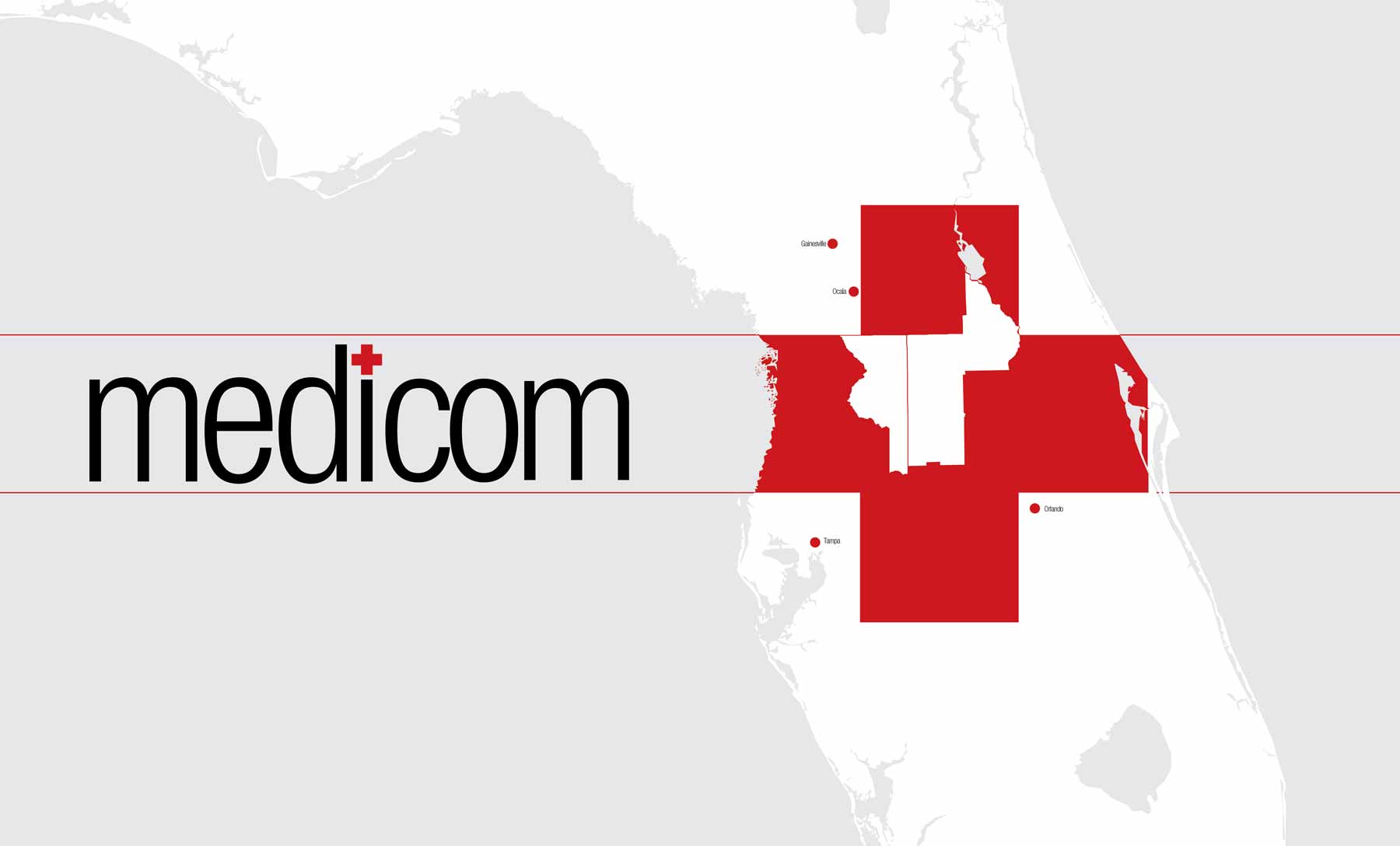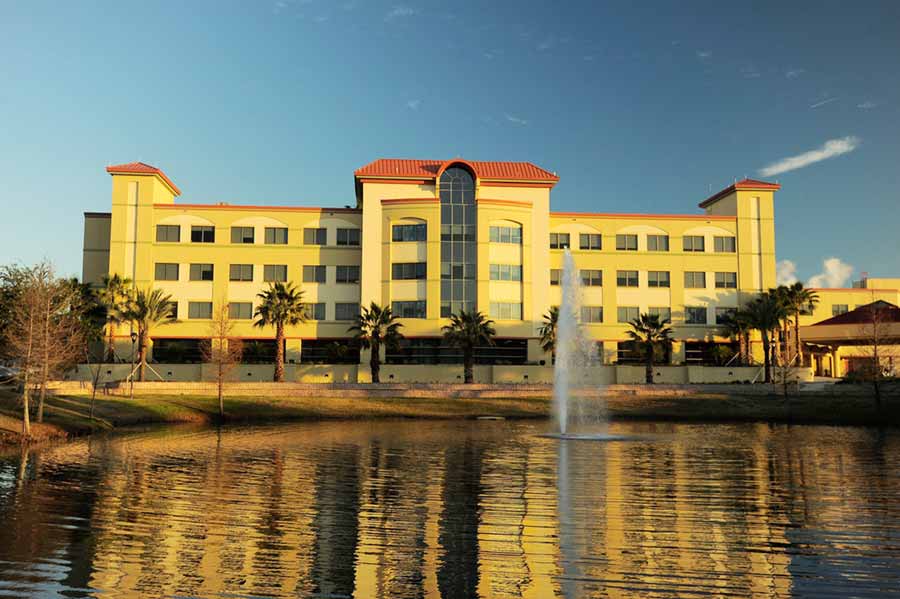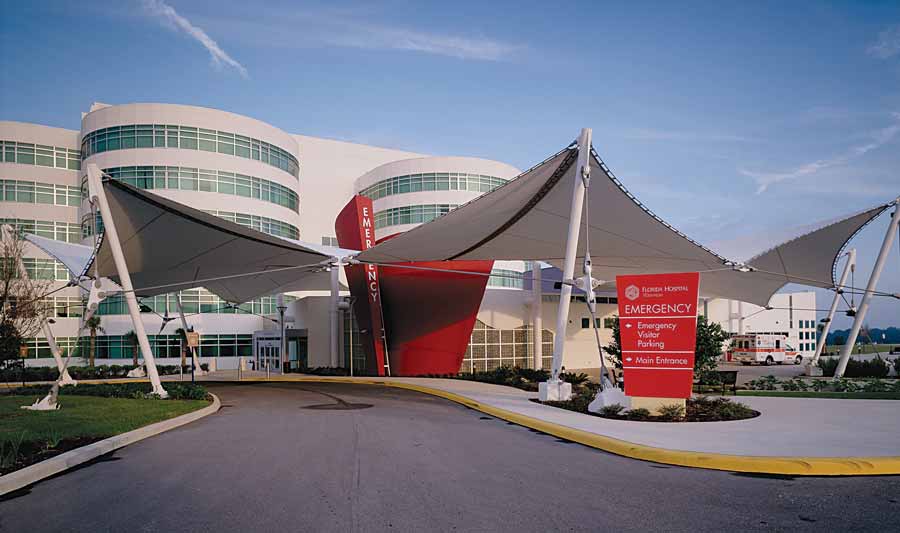Medicom
The complexity of urban development often begins with a simple yet brilliant idea from a single person and then grows through collaboration. In Lake County, the idea was to re-establish itself as a community committed to health and wellness. According to Dr. James Ray, an orthopedic surgeon currently with Nu Works who has worked in the South Lake area since 1992, South Lake began its transition with the vision of two men—CEO of Orlando Health John Hillenmeyer and Vice President of Orlando Health Shannon Elswick.
Both men shared the vision of establishing a wellness program in Central Florida. Together, they came up with a concept for a sports training facility.
Meanwhile, South Lake Hospital, a community hospital established in 1947, prepared to build a new, larger facility in Clermont. Hillenmeyer and Elswick saw this as a great opportunity and invited South Lake Hospital to partner with Orlando Regional Healthcare System, now called Orlando Health, in 1995. Together, they collaborated with South Lake Hospital administration, physicians, and USA Triathlon to establish the National Training Center, a world-class sports complex capable of training elite athletes—primarily triathletes, runners, cyclists, and swimmers. The National Training Center opened in 2001 on the South Lake Hospital campus in Clermont.
Almost simultaneously to the north, developer Harold Schwartz bought large tracts of land in the northeast portion of Sumter County and southeast corner of Marion County to continue expansion of his holdings in the northwestern corner of Lake County. Together with his son, H. Gary Morse, they envisioned a super-community for active seniors, having seen the success of other communities like Del Webb’s Sun City and offering even grander amenities and services to the residents of their previous development in the same location, Orange Blossom Gardens. Morse officially changed the name of the enhanced development in 1992 to The Villages.
Incredibly, The Villages’ population skyrocketed from 8,333 in 2000 to 51,442 in 2010. Since then, the community has more than doubled in size. According to the U.S. Census, approximately 114,350 people now call The Villages home. A wave of medical businesses, both traditional and alternative, followed. The impact is evident. The Villages adopted the slogan “America’s Healthiest Hometown.”
With heath care establishments developing in the north and south, Lake and Sumter counties were in prime position to develop as a health care hub. We have seen this phenomenon happen before, and it dramatically altered the identity and financial significance of the area where it occurred.
Silicon Valley, in the southern part of the San Francisco Bay area, is home to the majority of the world’s major high-tech corporations and to thousands of tech startup companies. Several factors came together so that Silicon Valley could become the tech hub it is today. Local universities, like Stanford and Berkeley, provided the educated STEM (Science, Technology, Engineering and Math) talent pool. Local industrial innovation attracted tech companies like Hewlett-Packard, Bell Telephone Laboratories, and Xerox PARC from 1955–1985. The semi-conductor and silicon transistor technology that followed attracted military interest and lucrative U.S. Department of Defense contracts. In the early 1970s, venture capitalists were attracted by the prospect of making millions in commercial use. Several venture capitalists beginning with Kleiner Parkins set up on Sand Hill Road. The availability of venture capital exploded in 1980, with the successful IPO of Apple Computer for $1.3 billion.
The Silicon Valley tech hub was born from the perfect blend of available educated workforce, local tech business industry, and an influx of available capital from government and private interests. A similar combination is blending in Lake and Sumter counties to create a world-class health care hub.
Ours is a medical community. Welcome to Medicom.
Highway to Health
Lake and Sumter counties are at the center of four major cities that are significant health care providers: Gainesville and Ocala to the north, Orlando to the southeast, and Tampa to the west. The proximity contributes to the fundamental reasons why the Lake-Sumter area is ideally positioned as a health care hub. They are close enough to provide information on the latest medical and health care advancements as well as talent, but still far enough that residents prefer closer services.
Lake-Sumter residents are essentially living on a corridor of health care opportunity and access.
U.S. Highway 441 passes directly and indirectly through all four hospitals in Lake County. From the north, it passes The Villages Regional Medical Center, plus rows of medical businesses that mushroomed off the highway around The Villages. As it passes through Leesburg, it connects with Dixie Avenue, which bypasses to Leesburg Regional Medical Center. Return to Highway 441, past Leesburg Animal Center and Lake Regional Urgent Care toward Tavares. Highway 441 passes right by Florida Hospital Waterman on 1000 Waterman Way. To reach South Florida Hospital in Clermont, turn off Highway 441 in Leesburg onto U.S. Highway 27 to State Road 50. The hospital is a mile and a half away.
With The Villages—America’s Healthiest Hometown—to the north and South Lake Hospital with the National Training Center and LiveWell Fitness Center in Clermont—recently rebranded “The Choice of Champions”—to the south, it is fair to say geography had a big impact on the development of our medical community.
So does the environment. There are more than 1,000 lakes in Lake County, which means the population is attracted to activities on the water. Swimming, water-skiing, and paddle-boarding are common. The Florida landscape lends itself to an active lifestyle, such as hiking, biking, running, and golf.
“Geographically, there is a natural tendency to want to be physical, and that translated to the need for a health care program that would allow people that lifestyle,” said Kim Couch, manager of community relations for South Lake Hospital.
Many of the hospitals and wellness centers are collaborating with local schools to build their talent base. Among them is South Lake Hospital.
“We partnered with Lake-Sumter State College and local Lake County schools this fall, launching a health and wellness collegiate academy,” said Couch. Incoming high school freshman apply for the program. It is focused on the health care field—science and technology. “The goal is to mold our local talent to remain in our community when they graduate,” she added. Upon graduation, they have a high school degree and an associate’s degree in health and wellness.
According to Vicky Mansavage, a consultant for the Regenerative Medicine Institute in The Villages, Central Florida provides other incentives for advances in technology and medicine, particularly financial ones.
“We have better tax laws,” Mansavage said, adding that state tax is designed to lower health care cost. That makes Florida a less expensive place to start a company.
Looking back on the ingredients for Santa Clara Valley in San Francisco to recreate itself as Silicon Valley— foundation, demand, talent pool, and financial incentives— it is easy to see how Lake and Sumter contains the essential components needed to transition as a health care hub. You have a health conscious foundation, a population that demands it, the educated pool to execute it, and the financial incentives to nurture both startups and national attractions, like the National Training Center.
Everything Right, Here
Residents can feel confident all their health care needs can be met here in Lake and Sumter. They run from the traditional to the alternative.
Each of the four hospitals offer specialties for which they are internationally revered. TVRH, for instance, offers the state-of-the-art da Vinci Surgical System, an effective robotic minimally invasive alternative to open surgery and laparoscopy.
Leesburg Regional Medical Center has the Primary Stroke Center and the Urgent Care Center.
Florida Hospital Waterman has the Cancer Institute, the Joint Replacement Center, and the Women and Children Center. “Our Cancer Institute has been one of the busiest in the region for quite some time,” said Steve Jenkins, director of marketing and communications. “We offer a full range of services based around oncology; we have been on the cutting-edge of some of the newest technology, and services available for cancer treatment.”
The program of particular note is the MAKOplasty robotic partial knee resurfacing, offered at the Joint Replacement Center, led by Dr. John Radnothy, a board certified orthopedic surgeon. The specialized implant offers a revolutionary FDA-approved method toward total knee replacement, retaining all of the original ligaments, thus the best option for long-lasting pain relief.
In addition to its world-class National Training Center and LiveWell Fitness Center, South Lake Hospital is revered for its Wound Care Center. The center introduced a pair of hyperbaric chambers that provide deep-dive oxygen therapy—the first of its kind in South Lake.
South Lake Hospital offers its own specialized robotic microsurgery, also utilizing the da Vinci Surgical System in what they call the Personalized Urology and Robotics (PUR) Clinic. In this case, for urology.
“We have one of the best robotic microsurgery programs for male infertility and chronic groin and testicular pain,” said Dr. Jamin Brahmbhatt, co-director of the PUR clinic. “Half of our patients come from outside the area. Because of that, we are sort of a medical tourism destination for the management of these chronic problems.”
Dr. Brahmbhatt commends South Lake Hospital for its innovative practices. “I was courted by several different hospitals, yet none offered what we were offered here. We are out-of-the-box thinkers, and are experts in our fields in terms of robotic microsurgery.”
Lake and Sumter are also known for their noteworthy innovative alternative medicines. The Salt Room is a wellness spa that uses salt therapy for esoteric health. Owner Rebecca James had her own reasons to believe in the treatment and open her spa.
“I had a 2 year-old son at the time who suffered from several respiratory problems,” James said. “He had severe allergies. They tried to put him on nebulizers, and other forms of medication. As a mother, I did not want them to do that because of the side effects. He was so little.” Her business partner, Ashley, opened up her spa and advised James to bring her son. “I did, and he responded,” she said.
James found a spa expert who believed in the benefits of salt therapy, which originated in the salt mines in Estonia. She learned everything she needed to know about the therapy to open her business and selected The Villages because the people she encountered desired the benefits of a healthy lifestyle and were open to new and innovative ideas. Others found similar appeal throughout the county for their latest medical innovations.
Bill Rowland is the founder and CEO of E-Med (Energy Medicine). His team treated the elite of professional sports with electric medicine for over 30 years. The primary focus is to eliminate pain if nothing else works. That is done through electrical technology.
“Our whole body runs on electricity, and whenever there is personal pain, injury or disease, there is always an interruption of the electrical properties of the tissue,” said Rowland.
Machines analyze it and respond with the exact signal necessary to bring the tissue back to its normal condition. In that normal condition, the body has an amazing ability to heal itself.
“We are now using this technology that was once reserved as a secret weapon in the backroom for professional sports teams—and introducing it to the general public,” Rowland said.
“Here in Clermont, amniotic fluid flow therapy is the next level of science in tissue and cellular technology that can help with the management of diseases,” said Dr. Ray.
He recalled the case of a university soccer player with a meniscal tear documented with a MRI that was treated with amniotic fluid. The follow-up MRI demonstrated the healing of the tear. The radiologist who read the first MRI read the second and commented on the healing of the tear, but felt the patient must have had interim surgery. “Needless to say mom and patient are happy,” said Dr. Ray.
The Regenerative Medicine Institute also provides amniotic treatment regulated by the FDA for soft tissue defects and general pain for conditions such as tendinitis and epicondylitis. “It will not heal neurological disorders,” said Mansavage.





